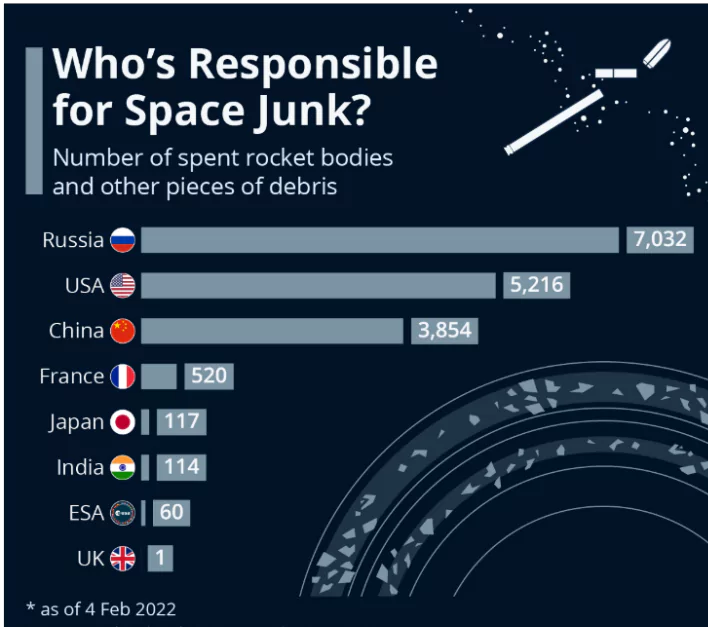Since space activity is growing at a rapid pace, the question of accountability for space debris has emerged as a critical issue in space governance.
About Space Debris
- Definition: The UN Committee on the Peaceful Uses of Outer Space (COPUOS) defines Space Debris as,
 Space debris is all man-made objects, including fragments and elements thereof, in Earth orbit or re-entering the atmosphere, that are non-functional.
Space debris is all man-made objects, including fragments and elements thereof, in Earth orbit or re-entering the atmosphere, that are non-functional.
- Example: Space Debris comprise of pieces of spacecraft, tiny flecks of paint from a spacecraft, parts of rockets, satellites (rocket boosters, fuel tanks that survive reentry), Fragments from satellite collisions, or explosions of objects in orbit flying
- Current Status of Space Debris: The total space debris estimated based on statistical models by the ESA are,
- Greater than 10 cm: 40500 space debris objects
- Greater than 1 cm to 10 cm: 1100000 space debris objects
- Greater than 1mm to 1 cm: 130 million space debris objects
- Orbits: The most polluted orbits in general are considered to be those between 200-2000 km above Earth (Lower Earth Orbits or LEO), and the 36,000 km orbit (Geosynchronous).
- Space Debris Law:
- Article VI of the Outer Space Treaty 1967: It says states bear responsibility for all national space activities, whether conducted by governmental or private entities.
- Convention for International Liability for Damage Caused by Space Objects of 1972: An “absolute liability” clause was introduced for damage caused by space objects on the earth.
- Under ‘absolute liability’ conditions, no proof of negligence is required and launching states are automatically responsible for harm caused by their debris.
- Rescue Agreement (1968):This treaty requires states to return any “foreign” space objects discovered in their territory to their owners and notify the Secretary-General of any such discoveries.
- Registration Convention (1975): This convention mandates the registration of objects launched into outer space.
- The Moon Agreement 1979: It indirectly addresses space debris by emphasizing on preventing environmental contamination and disruption on the moon as these objects can pose a threat to the environment of celestial bodies.
- Issues in Space Debris Governance:
- No Universal Definition: There is No universally accepted legal definition for space debris in international treaties.
- Enforcement Challenge: There is a gap between legal liability and practical enforcement, leaving affected parties vulnerable to inadequate resolutions.
- Example: The Soviet satellite Cosmos 954, carrying a nuclear reactor, crashed in Canada in 1978. Canada secured only $3 million of the estimated $6 million clean-up cost after prolonged diplomatic negotiations.
- Source Identification of Debris: Older, undocumented objects or highly fragmented debris may defy identification adding another layer of complexity in determining accountability.
- No Clear Authority: No clear authority is responsible for a rocket’s reentry or any damage it may cause once a space object is no longer actively controlled.
- Example: The US Federal Aviation Administration (FAA) in a response said its oversight ended when SpaceX lost control of the rocket which landed in Poland.
- Uncontrolled Reentries: There are no binding rules to penalise uncontrolled reentries until damage occurs and no international regulations that commit countries to proactive measures.
- Examples: China’s Long March 5B rocket core stage plunged uncontrolled into the southern Pacific Ocean, narrowly avoiding populated areas in 2024 reignited global alarm over space debris.
- Satellite Mega-Constellations: The rapid growth of satellite mega-constellations, such as SpaceX Starlink, Amazon Kuiper, and Eutelsat’s OneWeb, will add more than 100,000 satellites by 2030, increasing the risk of uncontrolled reentries.
- Not Binding Guidelines: Many older satellites lack deorbiting plans, worsening debris accumulation in orbit.
- As per UN’s rule, satellites should deorbit within 25 years are still voluntary, with only around 30% compliance, leaving thousands of decaying satellites in unpredictable orbits.
- Measures to be Taken:
- A Binding Global Regulation for Controlled Reentries: The UN Committee on the Peaceful Uses of Outer Space (COPUOS) must push for binding global regulations that require controlled reentries and penalties for non-compliant actors.
- Strengthen Domestic Policies: National governments need to strengthen domestic policies, requiring companies to adopt debris mitigation strategies as a condition for getting launch licenses.
- Tribunal: The 1972 Liability Convention must be modernised to include an independent international tribunal with binding enforcement powers.
- Adopt Debris Mitigation Strategies: Debris Mitigation Strategies like, disposal rules; controlled reentries or the ability to move to graveyard orbits should be made mandatory and enforced through sanctions or launch bans.
- Debris Tracking and Monitoring: Debris tracking systems, such as the US Space Fence should be expanded and improved for monitoring and reentry predictions.
- Adopt Sustainable Space Practices: Adopt practices like including debris-neutral technologies and reusable rockets, should also be incentivised to reduce clutter in orbit and enhance long-term safety.
Global Initiatives to Tackle Space Debris
- The Inter-Agency Space Debris Coordination Committee (IADC) facilitates information sharing and coordination among space agencies.
- Space Debris Mitigation Guidelines: The United Nations Committee on the Peaceful Uses of Outer Space has developed guidelines to minimize space debris by regulating spacecraft design, operation, and disposal.
- The NASA Orbital Debris Program focuses on research, tracking, and mitigation of space debris.
- The European Space Agency (ESA) is actively involved in developing technologies and missions to address space debris including,
- ESA’s ClearSpace-1 mission: It aims to remove a defunct satellite from orbit, demonstrating the technologies needed for active debris removal.
- ESA’s Zero Debris approach: It aims to significantly limit the production of debris in Earth and lunar orbits by 2030.
India’s Role in Tackling Space Debris
- ISRO System for Safe and Sustainable Space Operations Management (IS4OM): It has been established to focus all efforts related to spaceflight safety and debris mitigation and for dealing with the emerging challenges in operating in a congested space environment.
- Network for Space object TRacking and Analysis (NETRA): It has been approved for Space Situational Awareness (SSA) and capacity building.
- Collision Avoidance Analysis (COLA): For all Indian launch vehicles, Collision Avoidance Analysis (COLA) is performed to select collision threat-free lift-off time within the launch window
- Debris Free Space Mission (DFSM) Initiative: It is being spearheaded by ISRO with an aim to achieve debris-free space missions by all Indian space actors, both governmental and non-governmental, by 2030.
|
![]() 6 Mar 2025
6 Mar 2025

 Space debris is all man-made objects, including fragments and elements thereof, in Earth orbit or re-entering the atmosphere, that are non-functional.
Space debris is all man-made objects, including fragments and elements thereof, in Earth orbit or re-entering the atmosphere, that are non-functional.